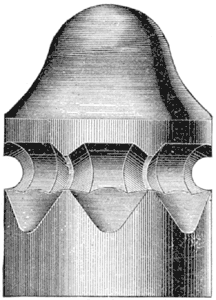[Trade Journal]
Publication: Electrical Review
New York, NY, United States
vol. 3, no. 10, p. 3, col. 3-4
The Fiske-Mott High Resistance
Insulator.
The principle of this insulator will become apparent to any electrician at a glance, and his first feeling will probably be one of surprise that he had not thought of it himself. Like most inventions that find their way instantly into use, it is extremely simple, and fulfils exactly the purpose for which it is intended.
In order to see clearly the reasons for the efficiency of this device, let us first review the conditions to be satisfied in an efficient insulator, and also the causes that operate to promote leakage.
In the first place, an insulator must be of very poor conducting material. The Chicago Insulator Company meet this requirement by making their articles of glass, or of a special patented composition of their own, possessing high insulating properties.
Secondly— An insulator should offer as little surface as possible to the wire, for the reason that the amount of conductivity of a body varies as to section, and the leakage of any line varies as the length of wire exposed to leakage. The insulation resistance of a line one mile long is twice as great as that of a line two miles long, simply because it exposes only half as much surface for leakage. Now, it is evident that the leakage upon any line is due almost wholly to leakage at the insulators; so that, if we can reduce the leakage at those points, we shall attack the evil at its root. Bearing in mind the fact that the amount of leakage varies as the surface exposed to leakage, we see at once a way to do this, i. e., decrease the amount of contact between the wire and each insulator. This is what is done in the device under consideration. The groove within which the binding and line wires are secured is simply corrugated or grooved, so that the wires lie upon a series of edges. The amount of surface of the wire exposed to leakage is, therefore, the sum of the surfaces of contact on the ribs.
 |
With the company's pattern, this sum is about one-tenth of that in an ordinary insulator. The insulation, therefore, is, roughly, ten times as great.
In the third place, an insulator should be so formed that water and dirt cannot lodge around the wire, because there would soon form a conducting layer over the surface. In this insulator there is no place for any such lodgment whatever, as the wire stands out clear from the surface.
In the fourth place, the device should be so formed, if possible, that the natural phenomena of wind and rain shall of themselves keep it clean; otherwise much labor will be entailed.
A glance will show how admirably this is here effected, for the wind and rain will evidently blow out and wash out any deposit that might otherwise accumulate about the wire.
For the rest, an insulator should be strong—not liable to break or crack in use or in transportation. As the ribs upon which the wire rests lie wholly within the groove, they are clearly protected from any accident, and the body of the insulator is made in the most approved and solid fashion.
It is believed that an impartial consideration of the practical requirements of an efficient insulator will lead to an emphatic indorsement of this one by all telegraph engineers.
The Chicago Insulating Company are evidently possessed of both judgment and enterprise, and we cordially wish them the success they deserve.
